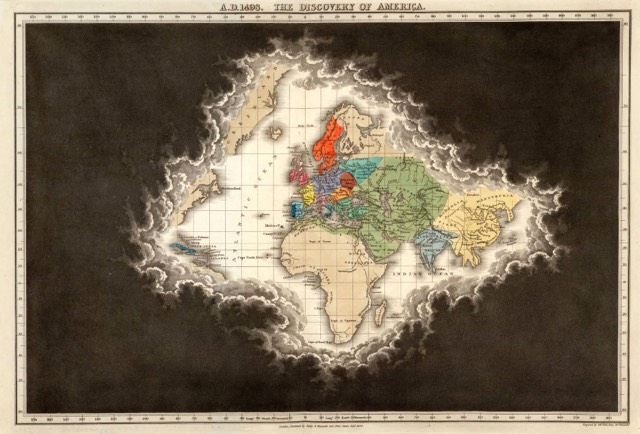General stuff to know going in
While there are important races up and down the ballot — not to mention referenda in many states — the two big national questions that will be decided tomorrow are
- Who’s going to be president?
- Which party is going to control the Senate?
If a huge Democratic wave develops, Democrats could theoretically also take the House, but nobody really expects that. (Afterwards, it will be interesting to add up vote totals and see which party’s candidates got more votes. In 2012, Democratic House candidates got more votes, but Republicans maintained their majority through gerrymandering.)
The presidential race is leaning to Clinton, though she is not in as good a position as Obama was in 2008 or 2012, and a Trump upset still can’t be ruled out. The Senate looks like a true toss-up; we’ll just have to wait and see — probably until Nevada’s race gets called sometime after midnight (on the east coast).
Senate. If Clinton wins, the Democrats need to net four seats to gain control. (VP Tim Kaine’s vote would break a 50-50 tie.) Two pick-ups are considered very likely: Tammy Duckworth winning in Illinois and Russ Feingold in Wisconsin. The third seat is probably Katie McGinty in Pennsylvania, who is favored. The fourth would be Maggie Hassan in New Hampshire, which is a coin flip. If all that happened, Democrat Catherine Cortez Masto would still have to hang on to the seat Harry Reid is retiring from in Nevada. Masto is favored there, but just barely. It’s not impossible that Democrats could also pick up seats in Indiana, Missouri, and North Carolina, but all those candidates are underdogs. Stranger things have happened than Marco Rubio losing his seat in Florida, but I wouldn’t bet on it.
Presidency. Here are two graphics you’ll want to refer to as returns come in and states get called. The first is the minimal Clinton win map from the NYT’s Upshot column.

Any result that deviates from that map — except for 1 electoral vote in Maine, which we’ll talk about later — is a clear signal that the election is not going to go down to the wire. If Trump wins Pennsylvania, say, or Clinton wins Florida, it might be over early.
The other important graphic (which I think is brilliant in a pure visual-presentation-of-information sense) is the snake from Nate Silver’s 538 site:

The two sites disagree on whether Nevada or New Hampshire is the last state Clinton needs to win. I favor the Upshot in this case, because Nate’s model only counts polls, while the Upshot is also factoring in the huge Hispanic early-voting turnout in Nevada, so a Clinton win in Nevada seems more likely, all things considered. 538’s Harry Enten seems to agreewith this analysis. (Nate Silver has a whole other argument going about the overall probability of a Clinton win, which he places lower than just about anybody but rabid Trump supporters. I’ll explain that disagreement in the weekly summary.)
What happens when on Tuesday night
Before 6 p.m. you’ll see some novelty returns from small precincts (like Dixville Notch in New Hampshire), and it’s possible that some exit polls will leak out. (Don’t trust them. The early exit polls in 2004 had Kerry winning.) But nothing genuinely newsworthy will happen before the first official poll-closing times at 6.
In general, the networks will not declare a winner in a state until all the polls in that state are closed, and will declare a winner right away only if the exit polls are stunningly one-sided. The closer a state appears to be, the more votes the statisticians will need to see counted before they’re sure which way it’s going.
Almost all the states will be called within two or three hours of their polls closing, and probably all of them within five or six hours. But really, really close races, the kind that need recounts, may not be decided for days or even weeks. (Remember Florida in 2000.)
So here’s how I expect the returns to come in.
 6:00 p.m. EST: parts of Indiana and Kentucky. You’ll see some raw vote totals start coming in (and probably favoring Trump), but no projections will be made about electoral votes. Clinton 0, Trump: 0
6:00 p.m. EST: parts of Indiana and Kentucky. You’ll see some raw vote totals start coming in (and probably favoring Trump), but no projections will be made about electoral votes. Clinton 0, Trump: 0
7 p.m.: the rest of Indiana and Kentucky, Vermont, Virginia, South Carolina, Georgia, parts of New Hampshire and Florida. Almost immediately, Indiana, Kentucky, and South Carolina should be called for Trump and Vermont for Clinton. Georgia should eventually go for Trump and Virginia for Clinton, but are likely to be more competitive. So that’s the first sign of how the presidential race is going: How close are the early returns in Virginia and Georgia?
Florida and New Hampshire are the really important important states here, but again, they’re not going to be called until all the polls have closed. (Florida looks like a 7 o’clock state at first glance, but check out that part of the panhandle under Alabama.)
Indiana is the first of the competitive Senate races: Evan Bayh (D) against Todd Young (R). I’d expect the decision to take a while in all the toss-up races; but if it’s called right away in either direction, that could be a signal of how the night is going. Trump 28, Clinton 3.
7:30 p.m.: Ohio, West Virginia, North Carolina. West Virginia should go immediately to Trump. Ohio and North Carolina should both be close and take longer to be decided. Trump needs to win both of them to have any chance. If either goes early to Clinton, we’re looking at a romp, but I wouldn’t expect that. If either goes early to Trump, it’s probably going to be a long night.
North Carolina is another close Senate race, with Richard Burr (R) favored over Deborah Ross (D), but not by much. Trump 33, Clinton 3.
8 p.m.: the rest of Florida and New Hampshire, Maine, Massachusetts, Rhode Island, Connecticut, New Jersey, Pennsylvania, Delaware, Maryland, District of Columbia, Michigan, Tennessee, Alabama, Mississippi, Illinois, Missouri, Kansas, Oklahoma, most of Texas, and parts of the Dakotas.
A bunch of this list should go right away, or before long: Maine, Massachusetts, Rhode Island, Connecticut, New Jersey, Delaware, Maryland, D.C., and Illinois for Clinton; Tennessee, Alabama, Mississippi, Kansas, Oklahoma for Trump.
Texas looks like an 8 o’clock state on the map, but there’s a tiny fragment under New Mexico that stays open until 9.
I’ll also guess that Georgia (Trump) and Virginia (Clinton) come in as expected.
Florida and New Hampshire should take a while. Trump absolutely has to have Florida, so if it goes to Clinton, whenever it goes, we have a winner. New Hampshire isn’t is part of Clinton’s minimum-victory map, but if she wins it she won’t need Nevada later on. so if it goes to Trump, she’ll have to make it up somewhere else, like Nevada or North Carolina.
Pennsylvania and Michigan are traditionally Democratic states where Trump thinks he has a chance, but the polls disagree. Missouri will eventually go to Trump, but maybe not right away. As with Virginia, how long they take to come in is a sign of how the night is going. If Trump wins either Pennsylvania or Michigan, he probably wins the election unless Clinton takes Florida. (That’s an unlikely combination, because it requires last-minute voters to break in opposite directions in different states.)
Maine is the first of two special cases, Nebraska being the other. Both award two electoral votes for winning the state, and one for each congressional district. Maine as a whole is going to Clinton and Nebraska to Trump, but Maine’s 2nd district is in the likely-Trump category. (That 1 electoral vote might matter.) So in the total so far, I’m awarding 3 of Maine’s electoral votes to Clinton but hanging back on the last one.
New Hampshire, Pennsylvania, and Missouri are the Senate races to watch. There’s an outside chance that Marco Rubio loses in Florida, but only if it’s a big night for Democrats across the board. Conversely, the Democrats have to have the Illinois Senate seat (Duckworth) to have any chance of taking back the Senate. Probably she wins almost immediately.
Clinton 91, Trump 88. Still waiting: Florida, North Carolina, Ohio, Pennsylvania, New Hampshire, Michigan, Missouri, and that 1 vote in Maine.
8:30. Arkansas to Trump. Trump 94, Clinton 91.
9 p.m. the rest of Texas and the Dakotas, New York, Louisiana, Wisconsin, Minnesota, Nebraska, Wyoming, Colorado, New Mexico, Arizona.
Texas is supposed to be closer than usual, but it’s probably not that close. I’ll concede it to Trump right away (especially since the bulk of the state has been counting votes already since 8). Trump also gets the Dakotas, Louisiana, Nebraska, and Wyoming.
Clinton gets New York. She’ll get Wisconsin, Minnesota, and New Mexico eventually, but it might take a while. Trump will get Arizona and that last vote in Nebraska eventually, but not yet. Colorado is one of the states that the election hinges on; Clinton has to have it. If Trump takes Colorado,there are still ways that he can lose, but he would have the inside track.
By now, I’m guessing that Pennsylvania and Michigan will have come in for Clinton and Missouri and that last Maine vote for Trump.
Democrats have to have the Wisconsin Senate seat (Feingold) and the Republicans have to have Arizona (McCain). If either goes the other way, so will the Senate. By now the Pennsylvania or New Hampshire Senate races might have been called either way.
Trump 164, Clinton 156. Still waiting: Florida, North Carolina, Ohio, New Hampshire, Wisconsin, Minnesota, Colorado, New Mexico, Arizona.
10 p.m. Iowa, Montana, Utah, Nevada, part of Idaho and Oregon. Montana goes to Trump immediately. Usually Utah would also, but the McMullin third-party effort makes this year interesting.
Of the waiting states, Arizona and that last Nebraska vote goes to Trump; Wisconsin, Minnesota, Colorado, and New Mexico to Clinton.
Probably the others are called about now too, but it’s hard to say how they’ll go. Probably Ohio goes for Trump (if Clinton gets it, the election is essentially decided). The others I’m going to start calling unpredictable.
Trump 197, Clinton 190.
unpredictable: Florida, New Hampshire, North Carolina
still waiting: Iowa, Utah, Nevada.
11 p.m. California, Washington, Hawaii, the rest of Oregon and Idaho. California, Washington, Oregon and Hawaii go for Clinton almost immediately. Idaho goes to Trump.
Iowa and Utah probably come in for Trump by now. Iowa is usually close and has only gone for Republicans once (Bush in 2004) since Reagan took it in 1984. But it has an extra-large segment of whites without college degrees, a.k.a. the Trump base.
Clinton 268, Trump 213.
unpredictable: Florida, New Hampshire, North Carolina.
So if any of the unpredictable states have come in for Clinton, she wins at 11. If they’ve all gone for Trump, it’s 268-261 and we’re all still biting our nails.
Midnight. No new states, but this is probably when Nevada comes in for Clinton, who wins with 274 electoral votes, even if she’s lost the unpredictable states. By now I’ll bet we still don’t know who won the Senate. There’s bound to be one Senate race that keeps everybody up until 3 a.m., though I can’t predict which one it is.
1 a.m. p.m. Alaska. Trump’s victory path includes winning Nevada, which I don’t think he will. But if he has won Nevada, Florida, New Hampshire and North Carolina, then Alaska puts him over the top with exactly 270. (Unless, by some miracle, McMullin has won Utah. Then it’s 268-264-6, and the election is headed to the House.)



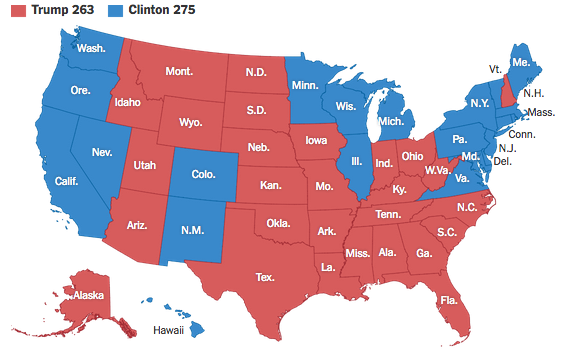
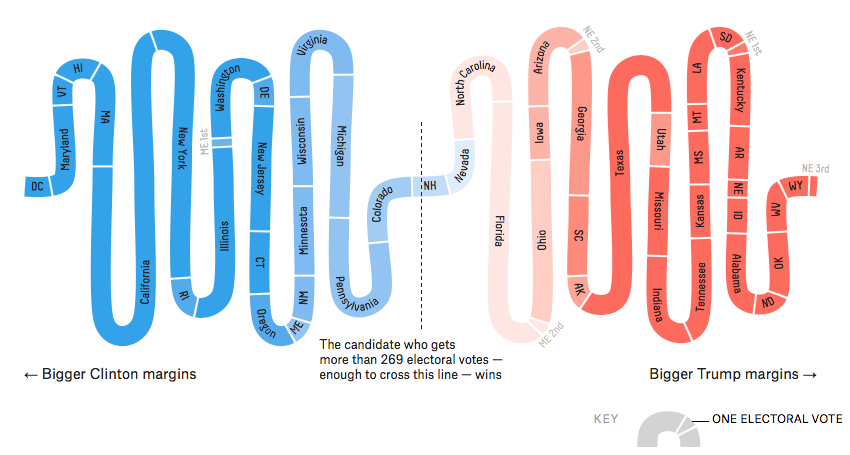

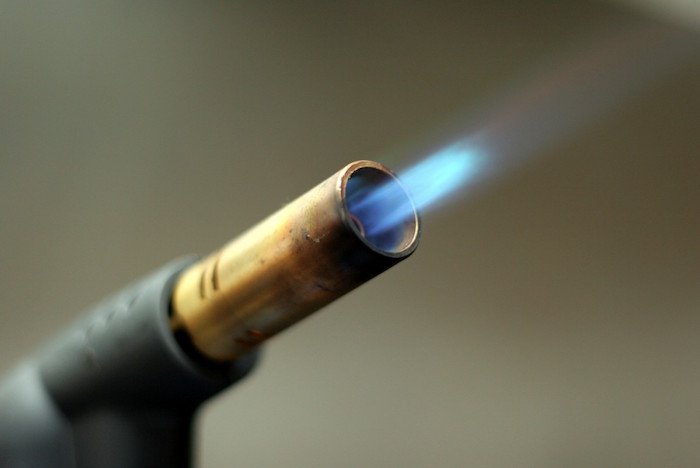







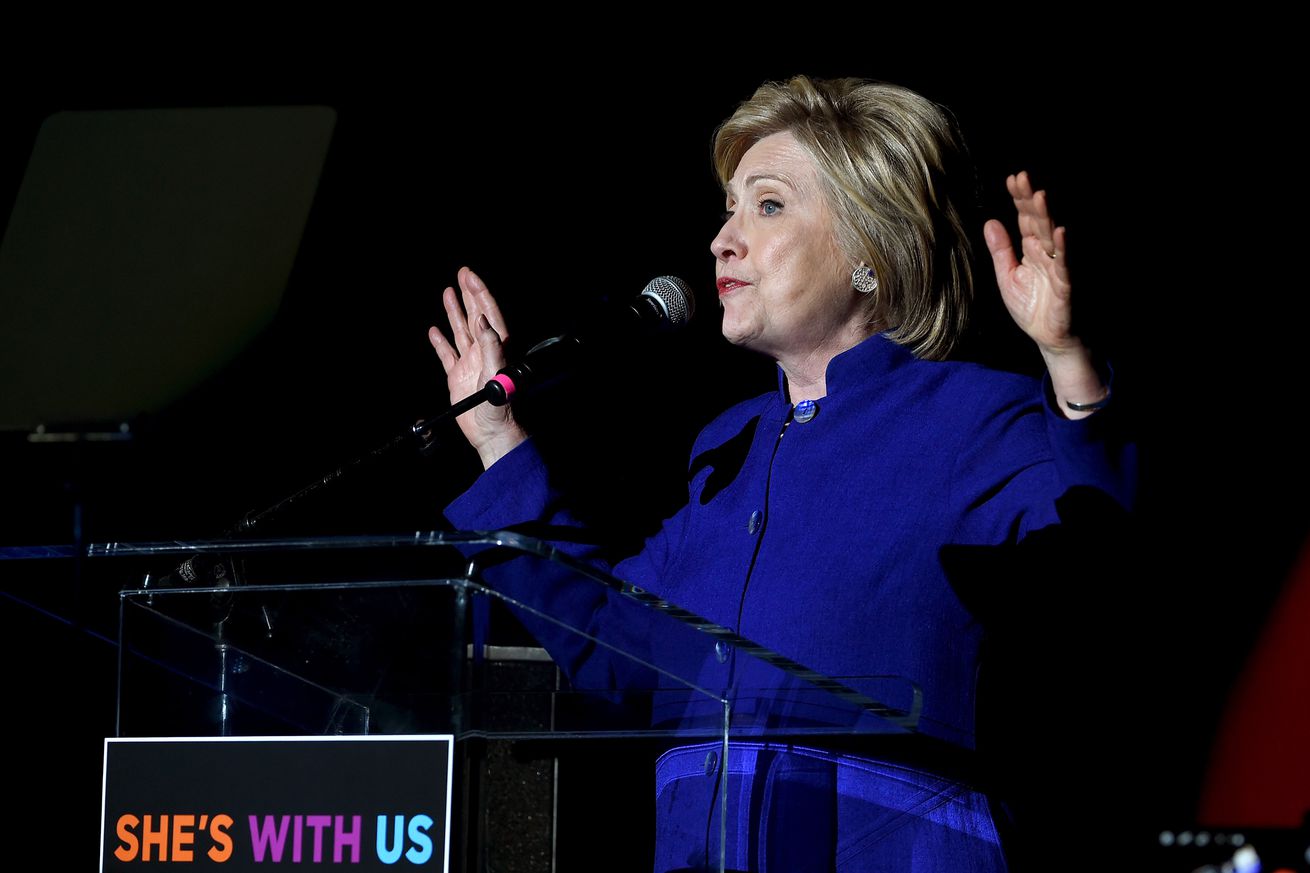
/cdn0.vox-cdn.com/uploads/chorus_asset/file/6577049/Screen%20Shot%202016-06-01%20at%2012.22.45%20PM.png)

